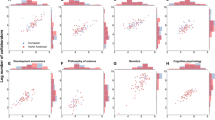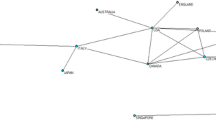Abstract
This essay investigates a number of the predictions of the theoretical view of scientific collaboration as a response to the professionalization of science: (1) that collaboration is most typically practiced by the scientific elite, or those who aspire to it, (2) that it increases individual research productivity, and (3) that it enhances the visibility of research to the larger scientific community. With respect to the first professionalized scientific community, that of Napolconic France, the study focusses on the research practices and careers of members of the Society of Arceuil, the Philomatic Society, and the First Class of the Institut, as they illustrate and confirm the accuracy of those predictions.
Similar content being viewed by others
Notes and references
D. deB. BEAVER., R. ROSEN, Studies in Scientific Collaboration. Part I. The Professional Origins of Scientific Co-authorship,Scientometrics, 1 (1978) No. 1, 65–84.
It appears to have diminished the importance of social class only to a certain extent and then only for a short time. Cf. M. CROSLAND,The Society of Arceuil, London, 1967, p. 202.
M. CROSLAND, op. cit.The Society of Arceuil, London, 1967, p. 202.
The Society of Arcueil, founded by LAPLACE and BERTHOLLET, was the most important private scientific society of the time. The society's counterpart today might be seen as the invisible college. See M. CROSLAND op. cit.The Society of Arceuil, London, 1967, p. 202, for a detailed study of this society.
M. CROSLAND, op. cit.The Society of Arceuil, London, 1967, p. 158–159.
Ibid. M. CROSLAND,The Society of Arceuil, London, 1967, p. 181.
The elite's control over the best scientific schools and research institutions of the time (the Ecole Polytechnique, the Ecole Normal Superieure, the Bureau des Longitudes, the Paris Observatory, the Museum d'Histoire Naturelle) gave its members facilities for directly appraising the abilities of the student generation and control over appointments to desirable positions, especially those in Paris. This often led to the appointment of a promising student to a position of assistant to one of the great savants of the time, which later resulted in collaboration either between the student and his master or between the student and one of the master's contemporaries. The careers of GAY-LUSSAC, BIOT, BERARD, and ARAGO all exemplify this procession of events.
DESCOTILS carried on work independently of FOURCROY and VAUQUELIN on what turned out to be platinum. Although Smithson TENNANT announced the discovery of this metal in 1804, it is reasonable to claim for DESCOTILS the independent discovery of the metal. However, “it took more than a century to bring DESCOTILS' process into use and he remained a pioneer without followers.” Quoted from D. McDONALD,A History of Platinum Metals from Earliest Times to the 1860's, 1960, p. 138, in M. CROSLAND, op. cit. p. 134.
Cf. M. CROSLAND, op. cit.The Society of Arceuil, London, 1967, pages 444–449 for a detailed exposition of their careers. Quotation in M. CROSLAND, p. 445.
Cited in M. CROSLAND, op. cit.The Society of Arceuil, London, 1967, p. 443.
Ibid. Cited in M. CROSLAND,The Society of Arceuil, London, 1967, p. 202.
Ibid. Cited in M. CROSLAND,The Society of Arceuil, London, 1967, p. 444.
Ibid. Cited in M. CROSLAND,The Society of Arceuil, London, 1967, p. 294.
Ibid. Cited in M. CROSLAND,The Society of Arceuil, London, 1967, p. 295.
Ibid. Cited in M. CROSLAND,The Society of Arceuil, London, 1967, p. 177.
This figure is approximate because it may include some members who were previously members of the First Class. However, this was not frequently the case: one could not expect to find there senior members of the Institute. The Philomatic Society, let us repeat, was a junior Academy. (M. CROSLAND, op. cit.The Society of Arceuil, London, 1967, p. 177).
The date of election to the first class was used as an indication of relative position within the community. Collaborators who were elected within five years of each other were assumed to be of equal standing. A difference of more than five years indicated a distinction in position. The snowball sample apparently exhausted nearly all significant collaborative research for this period as can be seen from the tables presented above. Almost all collaboration done by the elite is included in the sample. We will comment on this later.
D. deS. PRICE,Little Science, Big-Science, New York, Columbia University Press, 1963, p. 43–49.
A connection between quantity and quality was suggested in W. DENNIS, Bibliographies of Eminent Scientist,Scientific Monthly, LXXIX (Sept. 1954), p. 180–183, and confirmed for U. S. scientists, 1800–1860, in D. deB. BEAVER, The American Scientific Community, 1800–1860: A Statistical-Historical Study (Unpublished Ph. D. dissertation, Yale University, 1966), and also for physicists in S. COLE and J. R. COLE, Scientific Output and Recognition: A Study in the Operation of the Reward System in Science,American Sociological Review, XXXII (1967), p. 377–390.
H. ZUCKERMAN, Nobel Laureates in the United States: A Sociological Study of Scientific Collaboration, (Unpublished Ph. D. dissertation, Columbia University, 1965, p. 94). Her data show this to be the case for Nobelists compared with scientists who publish in core journals in physics and biology, but not chemistry. If Nobelists be compared with the scientists represented in abstracting journals, they far more frequently collaborate than the latter in all fields.
Further elaboration of this point appears in our forthcoming article dealing with more recent, scientific co-authorship, Studies in Scientific Collaboration. Part III. Professionalization and the Natural History of Modern Scientific Co-authorship.
For journals, see D. A. KRONICK,A History of Scientific and Technical Periodicals, 1665–1790, New York, The Scarecrow Press, 1962, and H. C. BOLTON,A Catalogue of Scientific and Technical Periodicals, 1665–1895, Washington, D. C., Smithsonian Institution, 1897.
Author information
Authors and Affiliations
Rights and permissions
About this article
Cite this article
de Beaver, D.B., Rosen, R. Studies in scientific collaboration. Scientometrics 1, 133–149 (1979). https://doi.org/10.1007/BF02016966
Received:
Issue Date:
DOI: https://doi.org/10.1007/BF02016966




